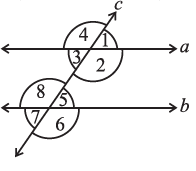Exercise 5.2 Page: 110
1. State the property that is used in each of the following statements?

(i) If a ∥ b, then ∠1 = ∠5.
Solution:-
Corresponding angles property is used in the above statement.
(ii) If ∠4 = ∠6, then a ∥ b.
Solution:-
Alternate interior angles property is used in the above statement.
(iii) If ∠4 + ∠5 = 180o, then a ∥ b.
Solution:-
Interior angles on the same side of transversal are supplementary.
2. In the adjoining figure, identify

(i) The pairs of corresponding angles.
Solution:-
By observing the figure, the pairs of corresponding angle are,
∠1 and ∠5, ∠4 and ∠8, ∠2 and ∠6, ∠3 and ∠7
(ii) The pairs of alternate interior angles.
Solution:-
By observing the figure, the pairs of alternate interior angle are,
∠2 and ∠8, ∠3 and ∠5
(iii) The pairs of interior angles on the same side of the transversal.
Solution:-
By observing the figure, the pairs of interior angles on the same side of the transversal are ∠2 and ∠5, ∠3 and ∠8
(iv) The vertically opposite angles.
Solution:-
By observing the figure, the vertically opposite angles are,
∠1 and ∠3, ∠5 and ∠7, ∠2 and ∠4, ∠6 and ∠8
3. In the adjoining figure, p ∥ q. Find the unknown angles.
Solution:-
By observing the figure,
∠d = ∠125o … [∵ corresponding angles]
We know that, Linear pair is the sum of adjacent angles is 180o
Then,
= ∠e + 125o = 180o … [Linear pair]
= ∠e = 180o – 125o
= ∠e = 55o
From the rule of vertically opposite angles,
∠f = ∠e = 55o
∠b = ∠d = 125o
By the property of corresponding angles,
∠c = ∠f = 55o
∠a = ∠e = 55o
4. Find the value of x in each of the following figures if l ∥ m.
(i)

Solution:-
Let us assume other angle on the line m be ∠y,
Then,
By the property of corresponding angles,
∠y = 110o
We know that Linear pair is the sum of adjacent angles is 180o
Then,
= ∠x + ∠y = 180o
= ∠x + 110o = 180o
= ∠x = 180o – 110o
= ∠x = 70o
(ii)
Solution:-
By the property of corresponding angles,
∠x = 100o
5. In the given figure, the arms of two angles are parallel.

If ∠ABC = 70o, then find
(i) ∠DGC
(ii) ∠DEF
Solution:-
(i) Let us consider that AB ∥ DG
BC is the transversal line intersecting AB and DG
By the property of corresponding angles,
∠DGC = ∠ABC
Then,
∠DGC = 70o
(ii) Let us consider that BC ∥ EF
DE is the transversal line intersecting BC and EF
By the property of corresponding angles,
∠DEF = ∠DGC
Then,
∠DEF = 70o
6. In the given figures below, decide whether l is parallel to m.
(i)

Solution:-
Let us consider the two lines l and m,
n is the transversal line intersecting l and m.
We know that the sum of interior angles on the same side of transversal is 180o.
Then,
= 126o + 44o
= 170o
But, the sum of interior angles on the same side of transversal is not equal to 180o.
So, line l is not parallel to line m.
(ii)

Solution:-
Let us assume ∠x be the vertically opposite angle formed due to the intersection of the straight line l and transversal n,
Then, ∠x = 75o

Let us consider the two lines l and m,
n is the transversal line intersecting l and m.
We know that the sum of interior angles on the same side of transversal is 180o.
Then,
= 75o + 75o
= 150o
But, the sum of interior angles on the same side of transversal is not equal to 180o.
So, line l is not parallel to line m.
(iii)

Solution:-
Let us assume ∠x be the vertically opposite angle formed due to the intersection of the Straight line l and transversal line n,

Let us consider the two lines l and m,
n is the transversal line intersecting l and m.
We know that the sum of interior angles on the same side of transversal is 180o.
Then,
= 123o + ∠x
= 123o + 57o
= 180o
∴The sum of interior angles on the same side of transversal is equal to 180o.
So, line l is parallel to line m.
(iv)

Solution:-
Let us assume ∠x be the angle formed due to the intersection of the Straight line l and transversal line n,

We know that Linear pair is the sum of adjacent angles is equal to 180o.
= ∠x + 98o = 180o
= ∠x = 180o – 98o
= ∠x = 82o
Now, we consider ∠x and 72o are the corresponding angles.
For l and m to be parallel to each other, corresponding angles should be equal.
But, in the given figure corresponding angles measures 82o and 72o respectively.
∴Line l is not parallel to line m.